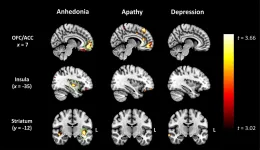Living in a majority-black neighborhood linked to severe maternal morbidity
Penn Medicine researchers studied the association between neighborhood-level risk factors and poor maternal health outcomes in Philadelphia between 2010 and 2017
2021-04-12
(Press-News.org) PHILADELPHIA - Residents in majority-Black neighborhoods experience higher rates of severe pregnancy-related health problems than those living in predominantly-white areas, according to a new study of pregnancies at a Philadelphia-based health system, which was led by researchers in the Perelman School of Medicine at the University of Pennsylvania. The findings, published today in Obstetrics and Gynecology, suggest that neighborhood-level public health interventions may be necessary in order to lower the rates of severe maternal morbidity -- such as a heart attack, heart failure, eclampsia, or hysterectomy -- and mortality in the United States.
The researchers retrospectively analyzed deliveries during a seven-year period at four hospitals within the University of Pennsylvania Health System and compared health outcomes to U.S. Census data. They found that the rate of severe maternal morbidity within a neighborhood increased by 2.4 percent with every 10 percent increase in the percentage of individuals in a Census tract who identified as Black or African American.
"Severe maternal morbidity disproportionately affects Black women. We know these differences are not genetic in etiology, but most likely due to structural racism and neighborhood-level risk factors," said senior author Jessica R. Meeker, PhD, MPH, who led the research as a third-year doctoral candidate in Epidemiology in the Perelman School of Medicine. "We wanted to explore this further and discovered that where you live is a key factor that affects maternal health outcomes."
Pregnancy-related deaths in the United States have doubled between 1987 and 2014, according to the Centers for Disease Control and Prevention (CDC). Severe maternal morbidity -- defined as "unexpected outcomes of labor and delivery that result in significant short- or long-term consequences to a woman's health" -- has risen by 75 percent over the past decade in the U.S., affecting more than 52,000 women annually.
While past studies have shown that the risk of severe maternal morbidity and mortality is markedly increased among women of color, individual risk factors alone -- such as medical comorbidities, maternal education, or income -- have not explained this disparity. Knowing that structural racism and historical segregation of neighborhoods are drivers of other poor health outcomes, such as diabetes risk, Penn Medicine researchers sought to determine whether neighborhood-level factors, like poverty, crime, and housing violations, contribute to severe maternal morbidity.
Using medical records, the research team analyzed all deliveries -- 63,334 in total -- between 2010 and 2017 at four hospitals in the University of Pennsylvania's Health System: the Hospital of the University of Pennsylvania, Penn Presbyterian Hospital, and Pennsylvania Hospital in Philadelphia, as well as Chester County Hospital, located in the Philadelphia suburbs. The health system presents an interesting case study, as it is large, and the four hospitals treat a racially- and economically-diverse patient population.
The primary outcome that the research team measured was severe maternal morbidity, defined as having at least one of the 21 indicators validated by the CDC. The team then obtained neighborhood-level information at the Census tract level from the U.S. Census Bureau and Open Data Philly, including poverty rate, violent and nonviolent crime numbers, rates of housing violations, and family income. Their study also included the percentage of those living in a given neighborhood who identified as white, Black, Asian, or Hispanic.
The researchers found that white race was the only statistically-significant, individual-level characteristic that was associated with lower odds of severe maternal morbidity. In terms of neighborhood-level factors, multiple characteristics were associated with an increased rate of severe morbidity. The most striking finding from the data was that, in the patient population studied, the rate of severe maternal morbidity increased by 2.4 percent in a given Census tract with every 10 percent increase in the percentage of individuals in the neighborhood who identified as Black or African American. Additionally, there was a 3 percent increase in the rate of severe maternal morbidity as the number of violent crimes in a given neighborhood increased.
"Since we found that neighborhood-level risk factors are independent predictors of severe maternal morbidity, this study gives further evidence that differences in race and maternal health outcomes are likely the result of historical and structural racism," said principal investigator Mary Regina Boland, PhD. "Improving our communities within the city of Philadelphia can help all individuals living in those neighborhoods, and may result in lowering rates of maternal morbidity for future generations."
Reducing maternal morbidity among Black women is a key goal of Penn Medicine. Efforts within the health system include standardizing procedures on labor and delivery, implicit bias training for physicians and staff, remote postpartum blood pressure monitoring, routine assessment of quality metrics including severe maternal morbidity stratified by race, and additional quality improvement efforts targeting disparities.
"This study gives us a blueprint for addressing racial disparities in health care at the neighborhood and population-level," said co-author Lisa Levine, MD, an assistant professor of Obstetrics and Gynecology at Penn. "Investing in neighborhoods that have been historically segregated, lacked access to government services, and subjected to racism will help to improve not only severe maternal morbidity, but also a host of other health outcomes for patients."
INFORMATION:
Penn authors Silvia P. Canelon and Ray Bai also contributed to this research, which was supported by Penn's Department of Biostatistics, Epidemiology & Informatics.
ELSE PRESS RELEASES FROM THIS DATE:
2021-04-12
April 12, 2021 - For critically ill COVID-19 patients treated with extracorporeal membrane oxygenation (ECMO), the risk of death remains high - but is much lower than suggested by initial studies, according to a report published today by Annals of Surgery. The journal is published in the Lippincott portfolio by Wolters Kluwer.
The findings support the use of ECMO as "salvage therapy" for COVID-19 patients with acute respiratory distress syndrome (ARDS) or respiratory failure who do not improve with conventional mechanical ventilatory support, according to the new research by Ninh T. Nguyen, MD, Chair of the Department of Surgery, University ...
2021-04-12
New research by Yale Cancer Center shows patients with early-onset colorectal cancer, age 50 and younger, have a better survival rate than patients diagnosed with the disease later in life. The study was presented virtually today at the American Association of Cancer Research (AACR) annual meeting.
"Although small, we were surprised by our findings," said En Cheng, MD, MSPH, lead author of the study from Yale Cancer Center. "Past studies have shown younger colorectal patients, those under 50, were reported to experience worse survival compared with patients diagnosed at older ages. We hope this result can be inspiring for these ...
2021-04-12
In a new study led by Yale Cancer Center, researchers have advanced a tumor-targeting and cell penetrating antibody that can deliver payloads to stimulate an immune response to help treat melanoma. The study was presented today at the American Association of Cancer Research (AACR) virtual annual meeting.
"Most approaches rely on direct injection into tumors of ribonucleic acids (RNAs) or other molecules to boost the immune response, but this is not practical in the clinic, especially for patients with advanced cancer," said Peter M. Glazer, MD, PhD, Chair of the Department of Therapeutic Radiology ...
2021-04-12
New research from CU Cancer Center member Scott Cramer, PhD, and his colleagues could help in the treatment of men with certain aggressive types of prostate cancer.
Published this week in the journal Molecular Cancer Research, Cramer's study specifically looks at how the loss of two specific prostate tumor-suppressing genes -- MAP3K7 and CHD1 --increases androgen receptor signaling and makes the patient more resistant to the anti-androgen therapy that is typically administered to reduce testosterone levels in prostate cancer patients.
"Doctors don't normally stratify patients based on this subtype and say, 'We're going to have to treat these people differently,' but we think this should be considered before treating ...
2021-04-12
KEY POINTS:
- Loss of pleasure has been revealed as a key feature in early-onset dementia (FTD), in contrast to Alzheimer's disease.
- Scans showed grey matter deterioration in the so-called pleasure system of the brain.
- These regions were distinct from those implicated in depression or apathy - suggesting a possible treatment target.
People with early-onset dementia are often mistaken for having depression and now Australian research has discovered the cause: a profound loss of ability to experience pleasure - for example a delicious meal or beautiful sunset - related to degeneration of 'hedonic hotspots' in the brain where pleasure mechanisms are concentrated.
The University of Sydney-led ...
2021-04-12
While the new Coronavirus will, hopefully, be effectively controlled sooner rather than later, its latest namesake is here to stay - a small caddisfly endemic to a national park in Kosovo that is new to science.
Potamophylax coronavirus was collected near a stream in the Bjeshkët e Nemuna National Park in Kosovo by a team of scientists, led by Professor Halil Ibrahimi of the University of Prishtina. After molecular and morphological analyses, it was described as a caddisfly species, new to science in the open-access, peer-reviewed Biodiversity Data Journal.
Ironically, the study of this new insect was impacted by the same pandemic that inspired its scientific name. Although it was collected a few years ago, the new species was only described during the global pandemic, ...
2021-04-12
New research shows that people who experience big dips in blood sugar levels, several hours after eating, end up feeling hungrier and consuming hundreds more calories during the day than others.
A study published today in Nature Metabolism, from PREDICT, the largest ongoing nutritional research program in the world that looks at responses to food in real life settings, the research team from King's College London and health science company ZOE (including scientists from Harvard Medical School, Harvard T.H. Chan School of Public Health, Massachusetts General Hospital, the University of Nottingham, Leeds University, and Lund University ...
2021-04-12
Between 2018 and 2020, 1,4 million EU citizens signed the petition 'End the Cage Age', with the aim of ending cage housing for farm animals in Europe. In response to this citizens initiative, the European Parliament requested a study by Utrecht University researchers on the possibilities to end cage housing. On 13 April, the scientists will present their report 'End the Cage Age - Looking for Alternatives' to the European Parliament.
In the report, behavioural biologists, animal scientists, veterinarians and ethicists from Utrecht University's Faculty of Veterinary Medicine analysed the available scientific literature on alternatives to cage housing. "Our focus was on laying hens and pigs" says Bas Rodenburg, Professor of Animal Welfare at Utrecht University. "Because these ...
2021-04-12
Many women "risk" allowing natural grey hair to show in order to feel authentic, a new study shows.
Researchers from the University of Exeter surveyed women who chose not to dye their grey hair, and found a "conflict" between looking natural and being seen as competent.
Participants in the study - mostly from English-speaking countries - belonged to online groups whose members allow their natural grey hair to show, and the researchers noted "solidarity and sisterhood" among these women.
"We are all constrained by society's norms and expectations when it comes to appearance, but expectations are more rigorous for women - especially older women," said lead author Vanessa Cecil, of the University of Exeter.
"The 'old woman' is an undesirable character in Western societies, being seen ...
2021-04-12
Why is sugar not transparent? Because light that penetrates a piece of sugar is scattered, altered and deflected in a highly complicated way. However, as a research team from TU Wien (Vienna) and Utrecht University (Netherlands) has now been able to show, there is a class of very special light waves for which this does not apply: for any specific disordered medium--such as the sugar cube you may just have put in your coffee--tailor-made light beams can be constructed that are practically not changed by this medium, but only attenuated. The light beam penetrates the medium, and a light pattern arrives on the other ...
LAST 30 PRESS RELEASES:
[Press-News.org] Living in a majority-black neighborhood linked to severe maternal morbidity
Penn Medicine researchers studied the association between neighborhood-level risk factors and poor maternal health outcomes in Philadelphia between 2010 and 2017





